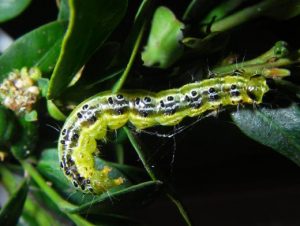
BOX TREE CATERPILLARS can cause severe defoliation to box plants. Find out where they come from, how to spot them and how to treat them
 This popular type of box plant (Buxus Sempervirens) has become very common in the UK, generally in formal gardens but now, more increasingly, informal ones too.
This popular type of box plant (Buxus Sempervirens) has become very common in the UK, generally in formal gardens but now, more increasingly, informal ones too.
In recent years, a serious pest problem has occurred concerning the Buxus Sempervirens in the form of a white, black and brown coloured moth. The female moth lays its eggs underneath the leaf of a box plant, which hatch into caterpillars that are green and yellow with black heads. When the caterpillar matures, it forms black and white lines along its body and can grow up to 4cm.
The first signs of diagnosing whether your box plant has been infiltrated is very tiny droppings underneath the shrub or webbing formed around a small area of the plant.
HOW DID THEY GET HERE?
The moth of the box tree caterpillar originates from East Asia and was first seen in Britain in 2008. The actual caterpillar itself was first reported in gardens in 2011 and, by early 2015, they established themselves throughout the UK and nearby countries. They continue to spread at an alarming rate.
Treatment
To prevent the shrub from losing its leaves, insecticide sprays are an effective way of dealing with the pests. However, plants in flower should not be sprayed due to the danger to pollinating insects and, if you don’t like using insecticides, the caterpillars can be found and removed my hand.
Most importantly, the problem needs to be addressed sooner rather than later as the caterpillars can completely defoliate the plant so you need to act quickly. Do not despair if your plant has been attacked - the plant stays alive even without its leaves, so it can still be saved!
